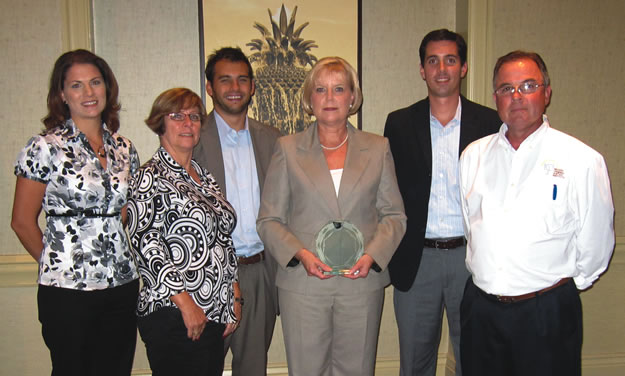Two Awards for E-Tickets
The Indiana Supreme Court has been honored with two national awards for its electronic Citation and Warning System (eCWS), also known as e-Ticket, which was created in 2007 by State Court Administration’s Judicial Technology and Automation Committee (JTAC). The system allows law enforcement officers to use a hand held device to scan a bar code on a driver’s license and vehicle registration to quickly create a traffic citation or warning. The record of those citations and warnings is then transmitted electronically to a single state depository of such records — and directly into Odyssey for those courts that are using it. More than 1,500,000 electronic citations and warning have been issued using the JTAC system.
The most important feature of eCWS is officer and motorist safety. State troopers report that it took 15 minutes to hand-write a ticket using the old ticket books but that it can take less than five minutes to issue an electronic ticket. Exposure to roadside tragedy has been dramatically reduced.
The Association of Transportation Safety Information Professionals presented its Best Practices Award at the 35th International Forum on Traffic Records & Highway Safety Information Systems in Arizona in July, and the Governors Highway Safety Association (GHSA) presented the Peter K. O’Rourke Special Achievement Award at the its national highway safety meeting in Savannah, Georgia on August 31st.

Mary DePrez, State Court Administration’s Counsel for Trial Court technology and Director of JTAC, said that both organizations were particularly impressed with the way in which eCWS is integrated with other trial court technology. For example, when a state trooper in Marion County issues an electronic citation (rather than writing a paper ticket), the digital record created is electronically transmitted to Odyssey and the case is filed (without any manual data entry by court or clerk personnel). The recipient of the citation can go online and pay the ticket (without having to write a check). Odyssey receives and records the payment (without any manual data entry by court or clerk personnel). Odyssey then prepares and sends electronically to the BMV State Form SR-16 after updating is made through a batch process in the application. The BMV computer system receives the SR 16 electronically and records the data in the motorist’s file (without any manual data entry by BMV personnel).
The Indiana State Police and more than 135 other law enforcement agencies across Indiana are using eCWS. The software and training are provided to law enforcement agencies at JTAC’s cost. The Indiana Supreme Court works in partnership with the Indiana State Police, Indiana Criminal Justice Institute, the Bureau of Motor Vehicles (BMV) and law enforcement officials including the Indiana Association of Chiefs of Police, the Indiana Sheriffs’ Association, and local departments across the state. Over a million warnings and tickets have already been created using e-Ticket. More information can be found online at courts.IN.gov/jtac/programs/ecws.html.
A National Forum
In September, Justice Frank Sullivan, Jr. attended the 2009 Court Technology Conference in Denver, Colorado hosted by the National Center for State Courts. Justice Sullivan was invited to be a panelist during a plenary discussion about the challenges faced by organizations like state judiciaries when implementing large scale technology projects. He praised Indiana Governor Mitch Daniels’s administration’s strong support for improved court technology in a speech to a plenary session at the Conference.
“I am of the view that there is no State in this country where there is closer and more constructive collaboration on technology between the judicial and executive branches of government than we have in Indiana,” Justice Sullivan said in his speech. “Indiana courts exchange court information electronically with agencies throughout the Daniels Administration in a way that increases public safety and saves taxpayers money.”
In addition to projects like eCWS with the BMV, Justice Sullivan said that Indiana courts also exchange court information electronically with the Indiana State Police, Indiana Department of Child Services (DCS), Indiana Department of Revenue, and the Indiana State Department of Health as agencies in the Daniels Administration. The Indiana Criminal Justice Institute, the Indiana Office of Technology, the State Board of Accounts, and the Indiana Department of Homeland Security, all agencies within the Daniels Administration, have also strongly supported the work of JTAC in improving court technology.
Justice Sullivan singled out for particular recognition the Indiana Criminal Justice Institute, the Chairman of its Board of Trustees, John R. von Arx, and its executive director, Dr. T. Neil Moore. “The Criminal Justice Institute, through its leadership and funding, has been instrumental in fostering many of the collaborative projects that Indiana courts have successfully undertaken with executive branch agencies. It has been a central force in our success.”
Justice Sullivan also expressed appreciation to the State Legislature. “Without the Indiana General Assembly’s support of JTAC and its projects, we could not have made the progress we have,” he said.
In his speech, Justice Sullivan listed the following examples in addition to the BMV project as “evidence of the strong working relationship between the judicial and executive branches of Indiana state government”:
Every domestic violence court notifies local law enforcement, the State Police, and the FBI electronically upon the issuance of a Protection Order;
Juvenile probation officers notify DCS electronically of delinquency cases for which DCS will be financing services for the youth involved;
The Revenue Department uses software developed by JTAC to notify county clerks of outstanding tax warrants; and
Clerks notify the State Health Department electronically when marriage licenses are issued.”
Justice Sullivan said that each of these individual projects is part of a much more ambitious initiative on the part of the Indiana Supreme Court to equip all Indiana courts with a uniform 21st century case management system called Odyssey that will connect electronically all courts with each other and with law enforcement, state agencies, and others that need and use court information. Installation of Odyssey is a multi-year project that is approximately 20% complete.
